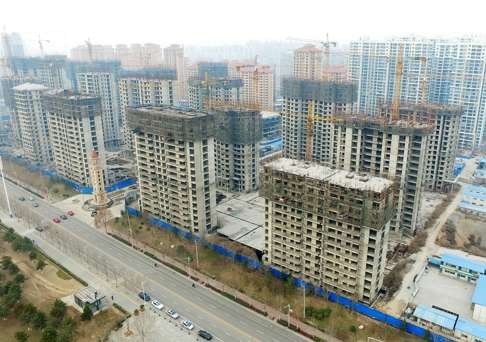
China’s red-hot property market drives growth, for now
Chinese banks extended a record 636 billion yuan (HK$763.2 billion) in new loans to households in March
A cyclical recovery in the Chinese economy seems to be underway, building on surging property prices and stronger construction activity. However, concerns are mounting whether the current credit expansion and property investment can be sustained, with some analysts even suggesting this rebound may not last long.
China’s property prices rose sharply in March, as new home prices were higher compared to the previous month in 62 out of 70 major Chinese cities, the highest proportion in more than two years, according to recent data from China’s National Bureau of Statistics.
Property sales of 37 major Chinese developers, including China Vanke and Poly Real Estate, rose an average 111 per cent in March from a year earlier, and were up 107 per cent from the previous month, according to research by Standard & Chartered.

“We have no doubt that we can brace for a fresh bout of headlines discussing the ‘return’ of Chinese property price bubbles and unsustainable debt levels,” said Annette Beacher, chief Asia-Pacific macro strategist for TD Securities.
The buoyant property market, supported by loose monetary policy, are helping to stoke up growth in what would otherwise be a faltering Chinese economy, according to analysts.
Last week, China reported first-quarter GDP growth moderated to 6.7 per cent from 6.8 per cent in the previous quarter, but the result was still in line with market expectations. March activity and credit growth data surprised on the upside, with notable growth acceleration in industrial production and fixed asset investment.
In particular, property investment jumped 9.8 per cent in March from a year ago, significantly higher than the 3 per cent rise in the January-to-February period on year.

Faster growth in property and construction activities have helped offset the slowdown in industrial and financial service sectors.
“Official growth would have slowed more had it not been for a policy-driven revival in real estate and construction,” said Julian Evans-Pritchard, China economist for Capital Economics in Singapore, in a recent note.
Evans-Pritchard said the cyclical recovery building on stronger construction and real estate activities may not last as the current credit expansion is unlikely to be sustainable.
Other analysts also raised concerns about what’s underpinning the rebound.
“The recent acceleration is fundamentally another credit-intensive FAI-focused demand rebound, ” analysts at Goldman Sachs said in a recent report. “Such a rebound is only effective in boosting short-term demand back to trend level.”
Further acceleration of activity will come at a cost of a continuous rise in inflation and leverage, neither of which is likely to be acceptable to policy makers, Goldman analysts said.
As export growth fades in the third quarter and the domestic policy stance normalises, Goldman expects China’s growth to moderate once again in the second half of the year.
Barclays forecast that the broad measure of money supply, or M2, and credit growth to normalise in the second half. The National People Congress has set an M2 growth target of 13 per cent. The People’s Bank of China, concerned about financial risks and currency pressures, will be reluctant to cut interest rates in the near term, providing a further brake on credit.
“The recent housing market rally and strong home sales are likely to reverse course in the coming months,” Barclays noted.
Following the introduction of tightened restrictions on property purchases in Shenzhen, Shanghai, and other cities, transaction volumes have already dropped markedly in the first two weeks of April.
Tom Rafferty, Asia economist for the Economist Intelligence Unit, said he believes property investment is not set for a period of sustained strengthening, as some major cities are tightening home-purchasing policies to cool prices, even as smaller cities struggle with excessive property inventories.

The growth momentum may falter in the coming months, as the structural issues facing China’s economy remain unresolved, he said.
“It has taken considerable monetary and fiscal policy loosening to stabilise economic growth at this level and this effort has distracted from the reform agenda that is fundamental to long-term economic sustainability,” Rafferty said, “Levels of debt within the Chinese economy are too high and we are concerned that the authorities are not moving quickly enough to address the issue.”

